August 8, 2025 | 14:37 GMT +7
August 8, 2025 | 14:37 GMT +7
Hotline: 0913.378.918
August 8, 2025 | 14:37 GMT +7
Hotline: 0913.378.918
In the country's northernmost region, two "hearts" have blossomed, both made by human hands. One is the heart-shaped terraced field in Then Phang hamlet (former Xin Man district); the other is the very first hanging reservoir, built in May 2002 in Sa Phin hamlet, nestled in the Dong Van Karst Plateau.
Mr. Sin Van Tinh, a resident of Diu hamlet, Then Phang commune, is the owner of the heart-shaped terraced field located at an altitude of 1,500 meters. Surely, the Nung man from Xin Man could never have imagined that, on the same land of his native Ha Giang, exactly 300 kilometers away from his village, another "heart" would bloom on stone. This "heart" was created by engineers and scientists from the Institute of Geosciences, and it was the first miraculous hanging reservoir piloted to store and retain water from rocky crevices.
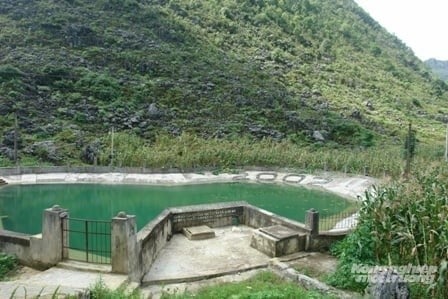
The Sa Phin hanging reservoir is the first heart-shaped reservoir built in the Dong Van Geopark in May 2002.

An inscription remains carved into the reservoir wall, marking the milestone of the first irrigation structure on the rocky plateau. Photo: Kien Trung
In the early 2000s, a group of experts and scientists from the lowlands traveled to survey the Dong Van–Meo Vac rocky plateau, laying the groundwork for a series of projects, such as constructing hanging reservoirs on the karst mountains. The initiative was primarily led by Assoc. Prof. Dr. Vu Cao Minh and Mr. Nguyen Chi Ton, Deputy Director of the Ha Giang Department of Agriculture at that time.
Dr. Vu Cao Minh once recalled that he and his colleagues made dozens of trips to the plateau, visiting each village to persuade local authorities and residents to support the construction of the reservoirs. In order to gain the people's consensus, they had to secure alignment from commune officials down to village heads. Only when villagers agreed to allocate land could construction sites be established.
In the rocky mountains, a wide and flat valley is a rare find. Building a reservoir requires such favorable terrain for easier construction, but it must also be near mountain crevices where water can be gathered. Mobilizing local support was not about issuing top-down directives stamped with red seals, but about living among the people, eating meals, and drinking wine with villagers.
In the mountainous regions, things must be done slowly, like small rain laying great dust. Nothing can be rushed, and certainly not imposed by command. Anyone who has worked in the highlands understands that culture.
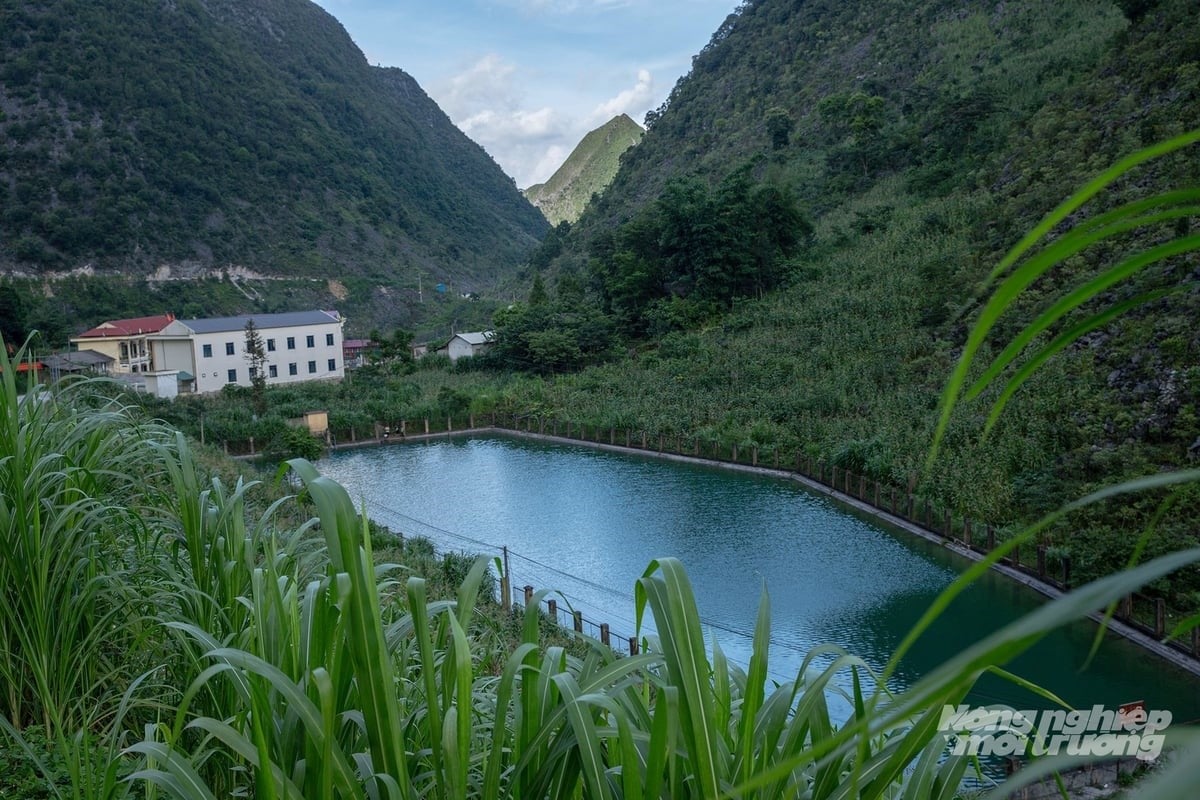
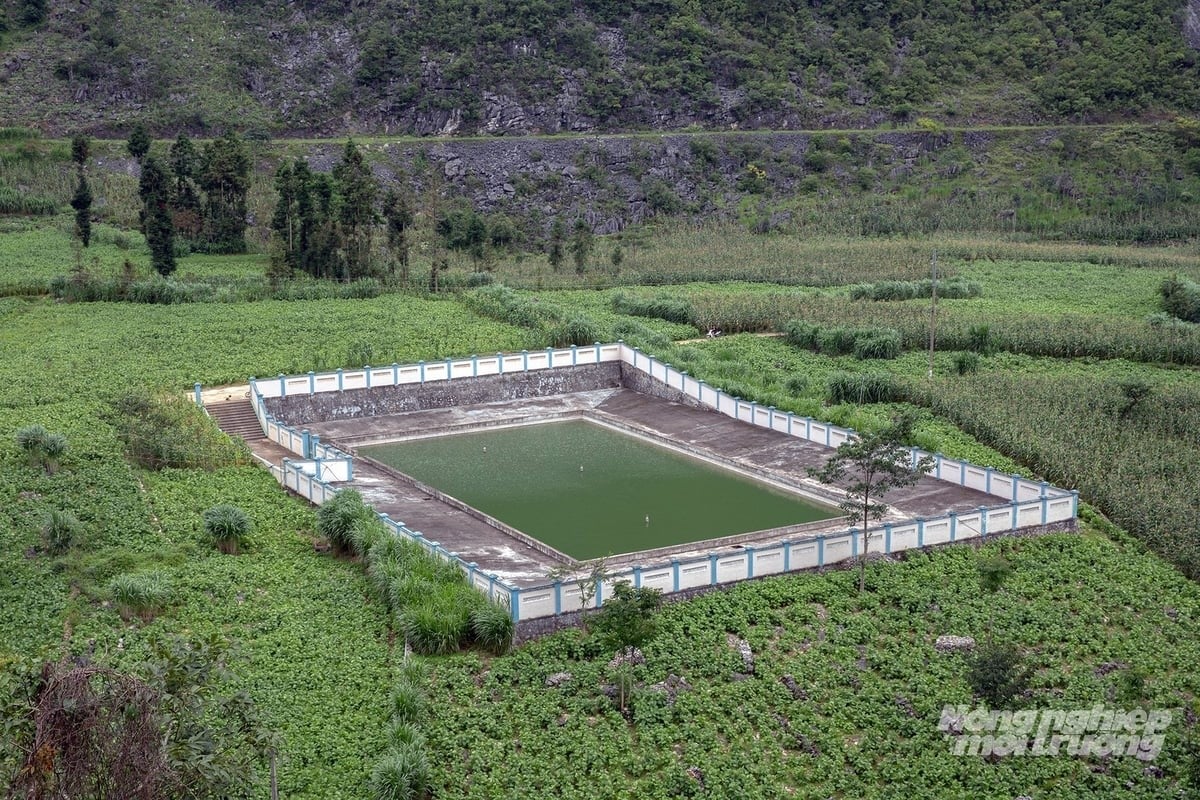
One reservoir after another was constructed amid the dreamy landscape of the rocky plateau. Photo: Khuong Trung.
Eventually, the team found a suitable site to build the hanging reservoir. Sa Phin reservoir, the very first irrigation structure on the plateau, was positioned at an elevation of 1,300 meters above sea level. Initially, the reservoir was designed with a waterproof canvas lining at the bottom to store water. However, during the trial phase, the pressure of water pouring down from above, combined with sharp bedrock pushing up from below, tore through the canvas. The team had to switch to a concrete bottom.
Local construction materials were scarce. Loads of sand, gravel, and cement had to be transported from Ha Giang town, over 100 kilometers away from Sa Phin. The mountain roads were rugged. In the early 2000s, the roads leading to the four mountainous districts were even narrow and winding, with high passes, deep valleys, and countless hairpin turns. Once the materials arrived, local laborers were mobilized to carry loads of stone, sacks of sand, bags of cement, and steel bars down to the construction site on their backs. With the persistence and patience of an ant colony, they got the job done.
After months of tireless effort, the Sa Phin hanging reservoir was completed in May 2002. Shaped like a heart, the reservoir sits quietly in a small, narrow but peaceful valley and holds up to 3,000 m³ of water. It was the first magnificent construction to appear on the rocky plateau and an astonishing sight for local residents, who had never seen a reservoir that could hold so much water.
On the wall of the Sa Phin hanging reservoir, a neat concrete inscription marks this milestone, an event that paved the way for a breakthrough in mountain reservoir technology. From that point forward, the model would be replicated, becoming an optimal solution for storing water and addressing water shortages in dry areas.
Following the success of Sa Phin, the Ta Lung hanging reservoir, with a capacity of 30,000 m³, was built. In the 2006-2012 period, several more reservoirs were constructed, including the Can Chu Phin hanging reservoir (2011) and the Pai Lung reservoir, with a size of 7,000 m³ and total construction costs of VND 20 billion, to supply clean water for nearly 2,000 people.
Upon completion, each hanging reservoir is handed over to local authorities for use. Each commune sets up management groups to operate the water supply system, develop maintenance and sanitation plans, and promote the rational, efficient use of clean water. These efforts aim to safeguard the precious water sources achieved from tremendous investment and labor.

The Lung Cam hanging reservoir is currently in its dry phase, exposed to the sun and undergoing cleaning in preparation for water storage during the rainy season. Photo: Kien Trung.
According to Mr. Pham Duc Nam, Chairman of the People’s Committee of Dong Van Commune, formed by the merger of five communes and towns (Dong Van, Ta Lung, Thai Phin Tung, Ta Phin, and Pai Lung), there are currently 46 hanging reservoirs and 74 gravity-fed domestic water supply systems across the former Dong Van district. Over the years, these irrigation structures have provided and ensured clean water for daily use, thereby contributing significantly to local socio-economic development.
Over time, degraded and damaged works need to be liquidated and replaced. Local authorities have proactively reported these issues to the provincial government, enabling the development of plans, remedial measures, and investments for replacement, thereby stabilizing and improving the quality of life for local residents. At present, Dong Van is in the process of liquidating the Sa Phin hanging reservoir, along with nine other degraded gravity-fed domestic water supply systems in Ma Le, Leng Sang, Sang Pa, Sa Lung, Ban Mo, Quan Dinh Ngai, Ma Lu, and Dong Van town that were degraded and ran out of usage time.
One emerging issue is the quality of water stored in hanging reservoirs. Due to the outdoor construction design, these reservoirs collect surface water from mountain crevices or natural rainfall, with relatively low surrounding walls. During heavy rains, surface runoff flowing through residential areas and livestock facilities can overflow into the reservoir. Moreover, while some reservoirs are equipped with an inlet filtration tank, they lack an outlet filtration system and a separate wastewater drainage channel.

Mr. Nguyen Chi Ton, whose name is mentioned on the plaque, was the Deputy Director of the Department of Agriculture of the former Ha Giang province. Together with Assoc. Prof. Dr. Vu Cao Minh, he trekked through forests and mountains to survey potential sites for the first hanging reservoirs. Photo: Kien Trung.
Due to their structural characteristics, water stored in hanging reservoirs over long periods can become stagnant and contaminated. Microorganisms cause discoloration and surface scum, while sediment gradually accumulates at the bottom.
Po Chua Lung hanging reservoir (Can Ty commune) and Sung La reservoir (Sung Thai commune) are among the first to show signs of water pollution. In response, the National Center for Rural Water Supply and Environmental Sanitation selected four reservoirs for piloting water treatment systems. These include rapid filtration tanks, stainless steel water containers, independent water supply zones, and various auxiliary structures.
Each year, the Ha Giang Provincial Center for Disease Control inspects and monitors the water quality of 20–30 hanging reservoirs. The Ha Giang Union of Science and Technology Associations also conducts water sample analyses from five reservoirs of Lung Tam Thap, Po Chua Lung, Ban Lo, Pa Vi Thuong, and Sa Lung to study water quality indicators and take appropriate treatment measures.
Specialized agencies recommend that for polluted reservoirs, communes guide residents in cleaning water sources and surrounding environments, removing algae and moss from the reservoir walls, and using chemicals to treat the polluted water.
However, the most crucial factor remains the management and operation by local communities and the awareness of residents who are the direct beneficiaries of the values brought by these hanging reservoirs.
Translated by Thu Huyen
![Sky-high reservoirs on rocky plateau: [3] A catalyst for ecotourism development](https://t.ex-cdn.com/nongnghiepmoitruong.vn/608w/files/huyenvt (e)/2025/08/07/3722-3-101858_203.jpg)
(VAN) More than just quenching the thirst of dry areas on the rocky plateau, hanging reservoirs are now contributing to the development of ecotourism.
![Sky-high reservoirs on rocky plateau: [2] Quenching the thirst in Can Chu Phin](https://t.ex-cdn.com/nongnghiepmoitruong.vn/608w/files/huyenvt (e)/2025/08/06/4406-4-214016_602.jpg)
(VAN) For nearly two decades, villages on the rocky plateau have had their thirst eased thanks to hanging reservoirs and solid water storage tanks built under poverty reduction projects.

(VAN) Ho Chi Minh City and Hyogo Prefecture strengthen cooperation on green transition, creating opportunities for clean agriculture, environmental technology, and climate change adaptation training.
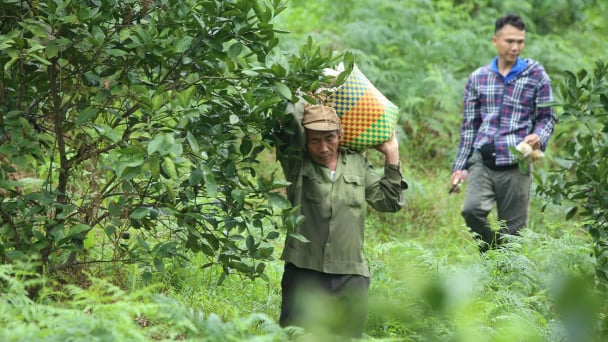
(VAN) With abundant water resources, North Central Vietnam is nurturing pineapple, tea, and citrus trees into sustainable brands, closely tied to resource management and a vision for development.
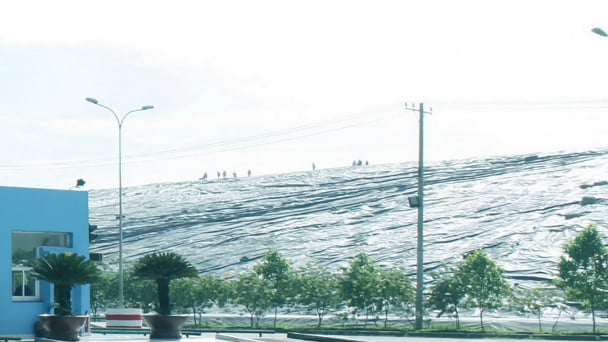
(VAN) Ho Chi Minh City is implementing a comprehensive set of measures to ensure that over 90% of municipal solid waste is treated using advanced, modern technologies by 2030.
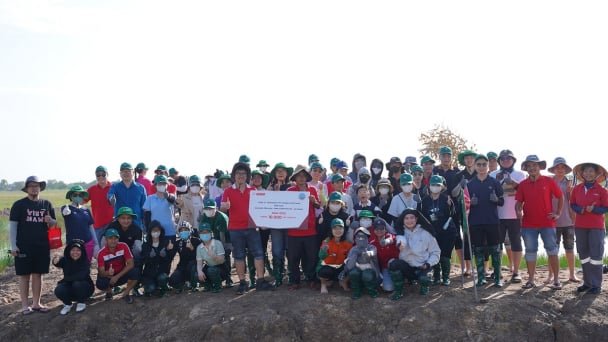
(VAN) INSEE Vietnam has planted 10,000 melaleuca trees at the Phu My Conservation Area, a new step in its goal to achieve a net positive impact on biodiversity by 2030.